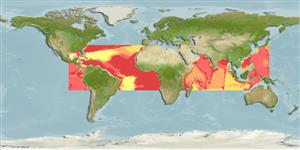Teleostei (teleosts) >
Stomiiformes (Lightfishes and dragonfishes) >
Stomiidae (Barbeled dragonfishes) > Astronesthinae
Etymology: Borostomias: Greek, boros, -a, -on = gluttonous + Greek, stomías, -ou = a tough, hard -mouthed horse (Ref. 45335).
Environment: milieu / climate zone / depth range / distribution range
Ecology
Marine; bathypelagic; depth range 500 - 2500 m (Ref. 58018). Deep-water; 36°N - 18°S, 98°W - 143°E
Eastern Atlantic: Madeira south to Angola. Western Atlantic: Gulf of Mexico and western Caribbean Sea. One specimen collected off the Guianas (Ref. 13608). Elsewhere, Indian and Pacific oceans.
Size / Weight / Age
Maturity: Lm ? range ? - ? cm
Max length : 35.0 cm SL male/unsexed; (Ref. 37039)
Dorsal spines (total): 0; Dorsal soft rays (total): 15; Anal spines: 0; Anal soft rays: 16 - 17. Teeth on maxilla 7. POSTORB single. AC greatly arched behind the anal fin base. Stem of barbel black; the distal end forming a small, spherical white bulb lacking filaments (Ref. 559). Body moderately slender and elongate. Serial photophores not broken in small groups. Black in color (Ref. 37039).
Quite common in deep oceanic waters, usually living deeper than 500 m during the day. Smaller individuals migrate to near-surface or even surface waters at night. Feeds on midwater fishes and crustaceans (Ref. 2802).
Life cycle and mating behavior
Maturity | Reproduction | Spawning | Eggs | Fecundity | Larvae
Gibbs, R.H. Jr., 1990. Astronesthidae. p. 300-307. In J.C. Quero, J.C. Hureau, C. Karrer, A. Post and L. Saldanha (eds.) Check-list of the fishes of the eastern tropical Atlantic (CLOFETA). JNICT, Lisbon; SEI, Paris and UNESCO, Paris. Vol. 1. (Ref. 4465)
IUCN Red List Status (Ref. 130435: Version 2024-2)
Threat to humans
Harmless
Human uses
Tools
Special reports
Download XML
Internet sources
Estimates based on models
Preferred temperature (Ref.
123201): 3.7 - 8, mean 5.2 °C (based on 724 cells).
Phylogenetic diversity index (Ref.
82804): PD
50 = 0.5156 [Uniqueness, from 0.5 = low to 2.0 = high].
Bayesian length-weight: a=0.00417 (0.00171 - 0.01014), b=3.05 (2.84 - 3.26), in cm total length, based on LWR estimates for this (Sub)family-body shape (Ref.
93245).
Trophic level (Ref.
69278): 4.0 ±0.67 se; based on food items.
Resilience (Ref.
120179): Medium, minimum population doubling time 1.4 - 4.4 years (Preliminary K or Fecundity.).
Fishing Vulnerability (Ref.
59153): Low to moderate vulnerability (33 of 100).
